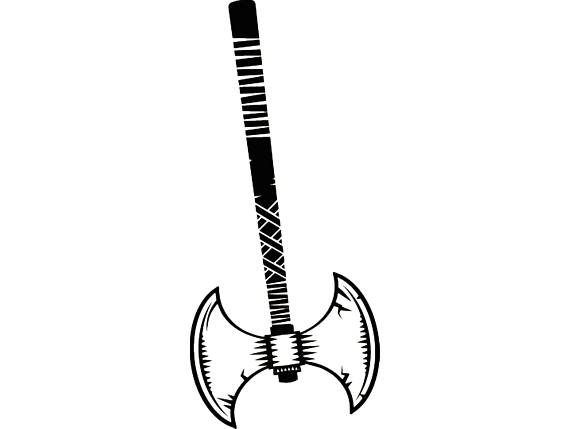
The battle-axe was a formidable weapon, but, since the warrior was unable to hold a shield at the same time as wielding the axe, he could be left vulnerable to arrows, missiles and thrusts from spears and swords. The thickening of the blade behind the edge indicates that the latter was formed from a strip, probably of hardened steel, which was welded into a wide groove in the end of the blade.Ĭontemporary illustrations such as the Bayeux Tapestry and examples of Danish and Anglo-Saxon sculpture show warriors wielding similar axes with hafts more than half the man’s height, or even reaching to the shoulder.

08-July 09 by Barry Agerįindspot: River Thames, probably at London, EnglandĪxe-head from a double-handed battle-axe of Petersen’s type M with a very broad, convex edge, and short, triangular projections above and below either side of the socket. The motifs on the axe can therefore be interpreted as both pagan and Christian. This hand-crafted Bearded Axe pendant is modeled after the large two-handed Viking battle axes found in parts of the Scandinavian and Rus areas of Europe. Gift For Him Medieval Hatchet Axe Battle Axe Bearded Axe War Axe. We know now more about these fascinating 5,000-year-old people. The Phoenix, on the other hand, is a symbol of rebirth belonging to Christian mythology. Viking Axes Hand Forged Hatchet Carbon Steel Personalized Wooden Box Gift For.

63.Ĭatalogue entry for Die Wikinger, Speyer, Germany, Dec. A new study published by the Royal Society reveals secrets about the mysterious Neolithic Battle Axe culture in parts of Scandinavia. If you are interested in one of my products, ask questions and I will be happy to help. Look at the pictures and others my items. Other names for the weapon include English long axe, Danish axe, and hafted axe. The surface polished, boat shaped, the convex sides swelling slightly around. The Dane axe is an early type of battle axe, primarily used during the transition between the European Viking Age and early Middle Ages. Without any doubt the battle axe is the most characteristic weapon of the Viking warriors. There seems to be some debate about whether these axes were symbolic in nature, more functional as a farming tool or used as a weapon.

(ed.) (1940): 'Viking Antiquities in Great Britain and Ireland IV', Oslo, 86 Graham-Campbell, J. A NORDIC DARK BROWN STONE BATTLE AXE NEOLITHIC PERIOD, CIRCA 2000-1700 B.C. Reproduction of an ornamented axe made of metal and wood. The ‘battle axe’ culture is named so because many goods buried in graves of the period include these stone, boat shaped, battle axes. (1927): 'London and the Vikings' (London Museum Catalogues, No. It is a widespread type, from Normandy to Finland, which appears to be that featured in the Bayeux tapestry. Found in the River Thames, from which several axes of this late, broad-bladed form (Petersen Type M) have been recovered.


 0 kommentar(er)
0 kommentar(er)
